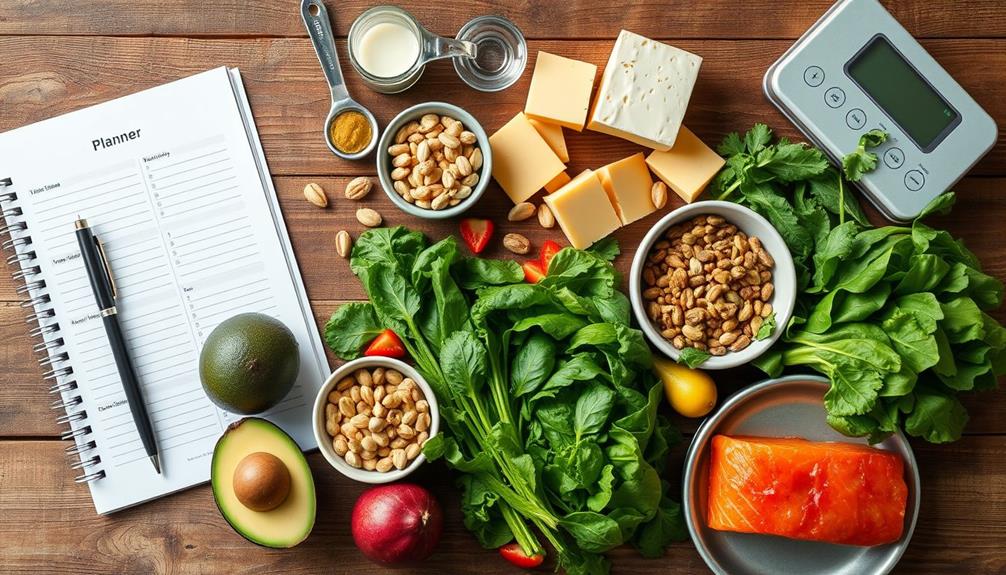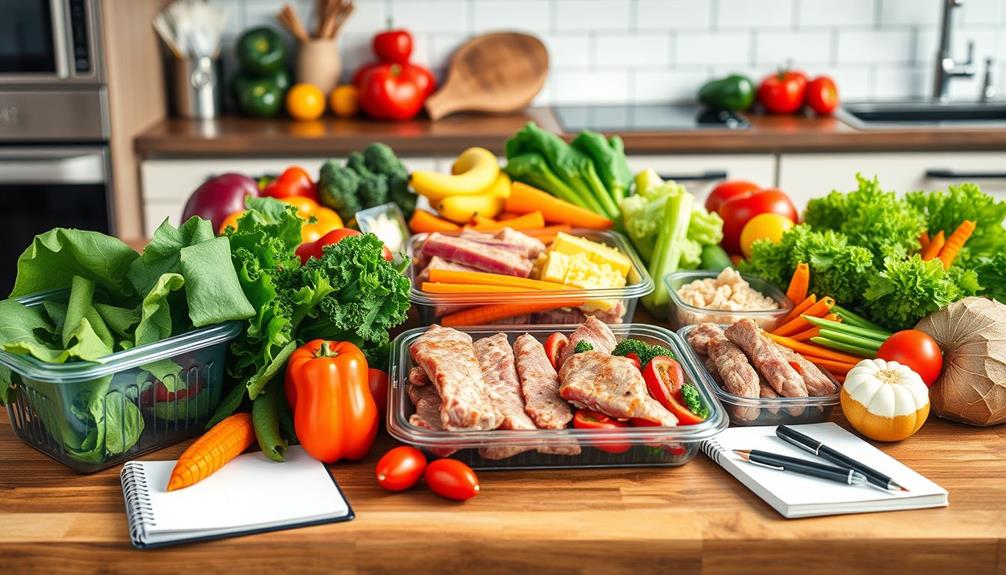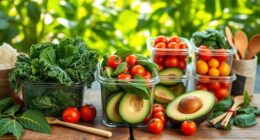To get started on a keto diet, focus on high-fat, low-carb foods. Limit your daily carb intake to 20-50 grams to trigger ketosis. Aim for a macronutrient ratio of about 70% fats, 20% protein, and 10% carbs. Include avocados, nuts, non-starchy vegetables, and high-quality meats in your meals. Create a meal plan to stay organized and consider batch cooking to save time. It's also essential to stay hydrated and manage potential side effects like the "keto flu." As you set out on this journey, you'll uncover more tips and strategies to help you succeed. Check out resources like a beginner’s guide to keto to learn more about the diet and get meal ideas. Keep track of your progress and adjust your meals and macros as needed. Remember, it’s a lifestyle change, so be patient and give your body time to adapt and reap the benefits of the keto diet.
Key Takeaways
- Begin by calculating your macronutrient needs, aiming for 70% fats, 20% protein, and 10% carbs to achieve ketosis.
- Stock up on high-fat foods like avocados, nuts, and olive oil while avoiding sugar and starchy foods.
- Plan meals around non-starchy vegetables, quality proteins, and full-fat dairy to maintain nutrient intake.
- Stay hydrated and increase electrolytes to prevent "keto flu" symptoms during the initial adaptation phase.
- Gradually reduce carbs over a week to ease into the diet and minimize gastrointestinal discomfort.
Understanding the Keto Diet

The ketogenic diet is a powerful approach to eating that focuses on high fat and low carbohydrates. By limiting your daily carb intake to just 20-50 grams, you can induce ketosis, a metabolic state where your body burns fat for fuel instead of carbs. This change can greatly aid in weight loss and improve your overall health.
The typical macronutrient breakdown of the keto diet consists of around 70% healthy fats, 20% protein, and only 10% carbs. Incorporating nutrient-rich foods like celery juice can enhance your hydration and provide vital vitamins during this shift. To get started, you'll need to create a meal plan that aligns with these ratios while considering any dietary restrictions you may have.
It's crucial to prioritize healthy fats, such as avocados, olive oil, and nuts, while managing your protein intake to support muscle maintenance.
Be aware that many beginners experience the "keto flu" during the initial adaptation phase, which can include fatigue and headaches. But don't worry—these symptoms usually resolve within a few weeks as your body adjusts.
Whether you choose a standard ketogenic diet or explore variants like the cyclical or targeted ketogenic diet, you've got options for flexibility in your approach.
Essential Foods to Include

Starting your keto journey means knowing which foods to prioritize in your meal planning. A successful ketogenic diet emphasizes high-fat foods and low-carb options to keep you in ketosis. Here are some essential foods to include:
1. High-Fat Foods: Focus on avocados, nuts, seeds, olive oil, and fatty fish. These should make up about 70-80% of your daily caloric intake.
Incorporating essential oils for health can also support your overall wellness during this dietary shift.
2. Non-Starchy Vegetables: Incorporate veggies like spinach, kale, cauliflower, and asparagus. They provide essential nutrients while helping you stay within your carb limits.
3. Protein Sources: Select high-quality meats such as beef, pork, chicken, and eggs. Aim for these to comprise about 15-20% of your daily calories.
4. Full-Fat Dairy: Include cheese and heavy cream in your diet but limit lower-fat options that may contain added sugars and carbs.
Be cautious with fruits; stick to low-carb options like berries and watch your serving sizes.
Meal Planning Strategies

Effective meal planning is essential for a successful keto diet, as it helps you stay on track with your macronutrient goals. Start by focusing on high-fat, low-carb foods, aiming for a macronutrient ratio of approximately 70% fat, 20% protein, and 10% carbohydrates. This will effectively put you into ketosis.
Create a weekly meal plan that includes a variety of non-starchy vegetables, healthy fats, and protein sources, ensuring you keep your daily net carbs under 20-50 grams. Batch cooking keto-friendly recipes like casseroles or stir-fries can save you time and curb cravings on busy days.
Don't forget to keep a list of go-to snacks such as cheese, nuts, or hard-boiled eggs to manage hunger between meals while staying within your carb limits. Using apps or food journals can help you track your macronutrient intake and adjust your meal plans based on your goals and energy levels.
| Meal Type | Examples |
|---|---|
| Breakfast | Scrambled eggs with avocado |
| Lunch | Salad with grilled chicken |
| Dinner | Zucchini noodles with pesto |
| Snacks | Cheese, nuts, hard-boiled eggs |
| Veggies | Spinach, cauliflower, broccoli |
Managing Side Effects

Meal planning can set you up for success on a keto diet, but you might encounter some side effects as your body adjusts. One common issue is the "keto flu," which can bring fatigue, headaches, and nausea for a few days to a week.
To ease these symptoms, focus on managing side effects effectively. Staying hydrated not only helps alleviate symptoms but is also essential for your overall health, especially when considering kidney health maintenance.
Here are four tips to help you through this change:
- Stay hydrated: Drinking plenty of water is fundamental. It helps alleviate symptoms and supports overall health.
- Increase electrolyte intake: Boost your sodium, potassium, and magnesium levels to counteract the loss of electrolytes during ketosis. Consider adding broths or electrolyte supplements.
- Gradually shift to a high-fat diet: Instead of making abrupt changes, slowly increase your fat intake to minimize gastrointestinal issues.
- Eat small, frequent meals: Incorporate high-fat and moderate-protein foods to maintain energy levels and reduce hunger pangs throughout the day.
If symptoms persist or worsen, consult a healthcare professional for personalized guidance and to rule out any underlying health issues.
Managing side effects is essential for a successful keto journey!
Long-Term Considerations

As you embrace the keto diet, it's vital to think about the long-term implications of this lifestyle change. While it can be an effective short-term weight loss strategy, many individuals find it challenging to maintain over time. Studies show that reverting to higher carbohydrate diets often leads to weight regain after initial success.
It's also important to ponder potential health impacts, such as cold medications overview, which highlight the importance of selecting appropriate supplements to support your health during dietary changes.
Additionally, sticking to a keto diet can increase the risk of nutrient deficiencies due to its limited food variety. To counter this, you'll need to carefully plan meals to guarantee you get a range of vitamins and minerals. Regular health check-ups are vital, as monitoring your cholesterol levels can help you manage heart health, given that individual responses to high-fat diets vary considerably.
If you decide to shift off the keto diet, do so gradually. Slowly reintroducing carbohydrates can help prevent digestive issues and unwanted weight regain.
Experts typically recommend using the keto diet for specific health conditions or short-term weight loss, followed by a balanced diet that includes a variety of foods for long-term health maintenance. Prioritizing balance guarantees you sustain your health and energy levels over the years.
Frequently Asked Questions
How Do I Start My Keto Diet for the First Time?
To start your keto diet, calculate your daily macronutrient needs, focusing on high-fat, low-carb foods. Plan meals ahead, stay hydrated, and prepare for the "keto flu" as your body adjusts to this new fuel source.
How Do Beginners Get Into Ketosis?
To get into ketosis, you'll need to cut carbs drastically, boost healthy fats, and stay hydrated. Monitor your ketone levels and gradually adjust your intake to ease into fat burning without feeling overwhelmed.
What Happens on the First 3 Days of Keto?
In the first three days of keto, you'll lose water weight, feel fatigued, and might experience "keto flu" symptoms. Your body starts burning fat for energy, so stay hydrated and monitor your electrolytes closely.
How Does the Keto Diet Work for Beginners?
The keto diet works for beginners by drastically lowering carbs, shifting energy from glucose to fat. You'll enter ketosis, burning fat for fuel, but might experience initial fatigue as your body adapts. Planning meals helps!
Conclusion
As you commence your keto journey, remember it's not just about cutting carbs—it's about finding a sustainable lifestyle that fits you. Picture yourself as a knight, forging your path through the modern-day food landscape, armed with knowledge and determination. Embrace the challenges, manage side effects, and prioritize your health for the long haul. With the right mindset and meal planning, you'll conquer your goals and reveal the benefits of this transformative diet. Happy feasting!








